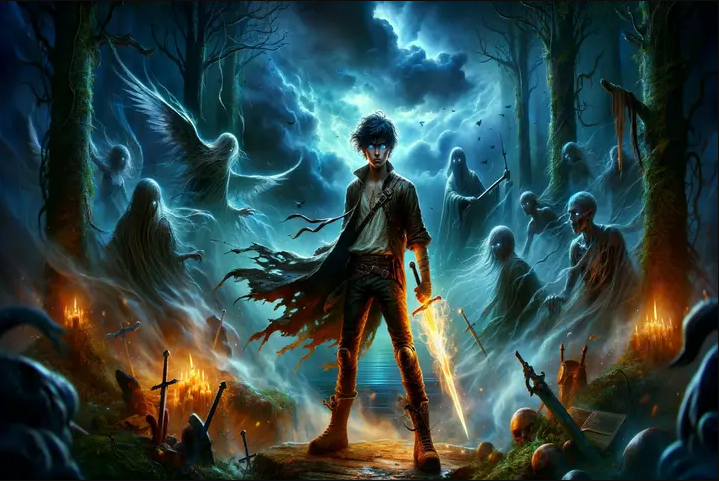Introduction:
At the core of this enigmatic figure lies the compelling narrative of the disowned child chronicles of unleashed divine bloodlust a force both awe-inspiring and terrifying in its manifestations. These individuals possess a unique blend of divine heritage and mortal frailty grappling with their dual nature as they navigate the tumultuous waters of identity and power.
From supernatural strength to ethereal beauty the disowned child embodies the intricate relationship between divine lineage and mortal existence. Their stories challenge us to consider fate resilience and the quest for dominance. So let’s travel back in time and explore these captivating tales that highlight the unbridled heavenly bloodlust of abandoned children.
Origins and Mythology:
Throughout history cultures across the globe have woven tales of the disowned child chronicles of unleashed divine bloodlust who walk the thin line between godhood and humanity. In Greek mythology we encounter figures like Perseus born of Zeus and a mortal woman Danaë. Perseus’s divine blood allowed him to slay the Gorgon Medusa yet he remained vulnerable to human emotions and weaknesses.
Similarly, Hindu mythology introduces us to Karna the son of the sun god Surya and Kunti a mortal queen. Karna’s divine lineage bestows upon him extraordinary abilities but his status as a disowned child abandoned by his mother shapes his tragic destiny. Karna’s inner conflict between loyalty honor and vengeance mirrors the struggle many such characters face.
Literary Interpretations:
In literature the disowned child chronicles of unleashed divine bloodlust often serve as allegories for marginalized groups, outcasts or those who defy societal norms. Mary Shelley’s Frankenstein presents us with Victor Frankenstein’s creation a being stitched together from disparate parts, abandoned by its creator. This creature grapples with its monstrous appearance seeking acceptance and understanding.
In modern fantasy, J.K. Rowling’s Harry Potter series introduces us to Tom Riddle later known as Lord Voldemort. Born to a witch mother and a Muggle father Riddle’s disowned status fuels his quest for power and immortality. His descent into darkness exemplifies the dangerous consequences of unchecked divine bloodlust.
Psychological Depth:
Beyond the supernatural the disowned child archetype delves into psychological complexities. These characters embody the tension between nature and nurture, destiny and free will. Their divine blood may grant them gifts but also burden them with expectations and isolation. The struggle to reconcile their dual heritage often marked by feelings of abandonment creates rich character arcs.
Contemporary Pop Culture:
In film and television, the disowned child chronicles of unleashed divine bloodlust continue to captivate audiences. Marvel’s Thor, the Norse god cast down to Earth grapples with his identity and responsibility. The TV series Lucifer portrays Lucifer Morningstar the fallen angel navigating life in Los Angeles. Both characters embody the divine bloodlust yearning for acceptance while battling their celestial origins.
How does divine bloodlust impact their relationships with others?
Divine bloodlust profoundly influences the relationships of those who bear it. Let us explore how this celestial hunger shapes their interactions with others:
Isolation and Alienation:
Disowned children often grapple with feelings of isolation due to their unique heritage. Their divine blood sets them apart making it challenging to connect with ordinary mortals. The thirst for power and otherworldly desires can lead to self-imposed isolation as they fear harming or revealing their true nature to loved ones.
Intense Bonds and Betrayals:
Divine bloodlust creates intense connections whether romantic or platonic relationships with disowned children are marked by passion and vulnerability. However, betrayal whether accidental or deliberate—can have catastrophic consequences. A disowned child’s wrath is formidable when provoked.
Struggle for Acceptance:
These individuals yearn for acceptance seeking allies who understand their dual existence. Finding someone who embraces both their humanity and divinity is rare. The fear of rejection often leads them to hide their true selves perpetuating a cycle of secrecy and emotional turmoil.
Power Dynamics:
Divine bloodlust grants immense power. Those who wield it may inadvertently dominate relationships, fearing vulnerability or losing control. Whether they protect or exploit their loved ones depends on their moral compass and inner conflict.
Temptation and Redemption:
Divine tempts the disowned child chronicles of unleashed divine bloodlust toward darker paths. Their struggle lies in resisting destructive urges. Redemption often involves sacrificing their celestial power for love compassion or a sense of belonging. In short, divine bloodlust shapes relationships through isolation intensity acceptance power dynamics and the eternal battle between celestial hunger and mortal bonds.
Conclusion:
The disowned child chronicles of unleashed divine bloodlust is a timeless motif that transcends cultural boundaries. Whether wielding a sword, casting spells or brooding in a penthouse these characters remind us of our shared humanity the struggle to belong find purpose and quench the insatiable thirst for power. So as we explore their chronicles let us ponder the delicate balance between godhood and mortality and perhaps glimpse our own reflections in their celestial eyes.






